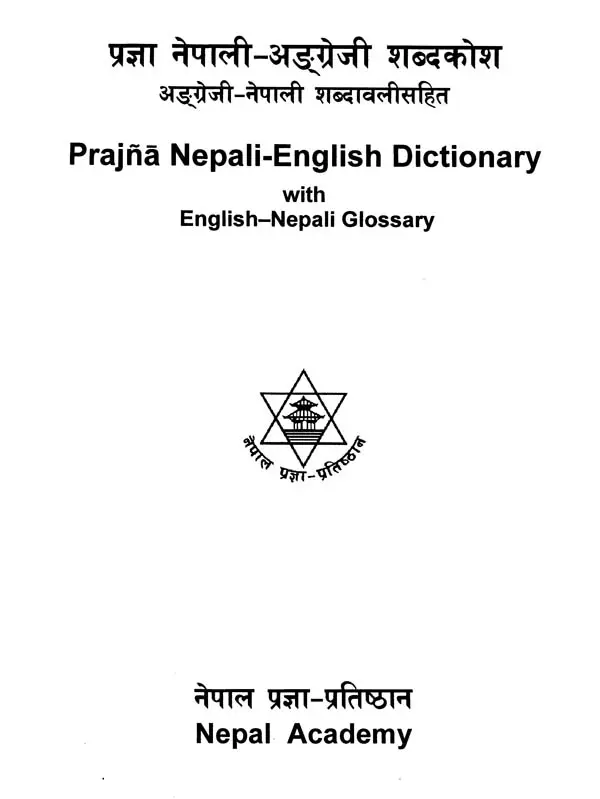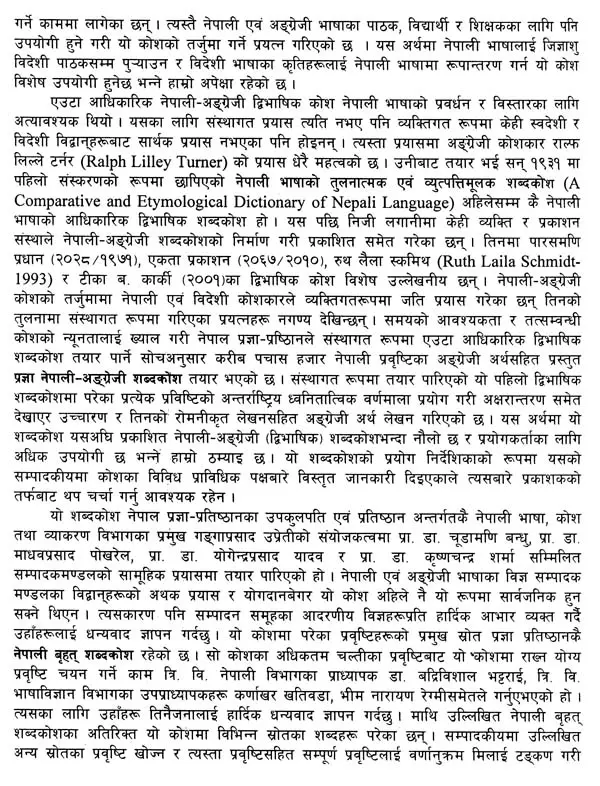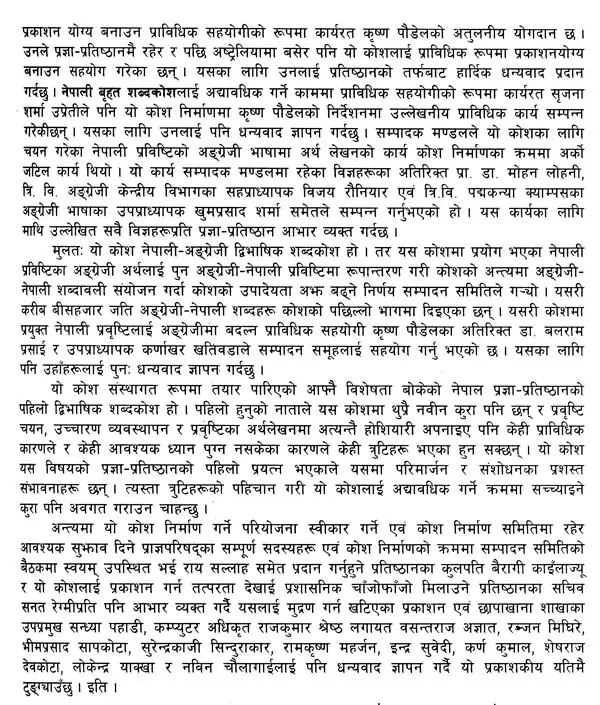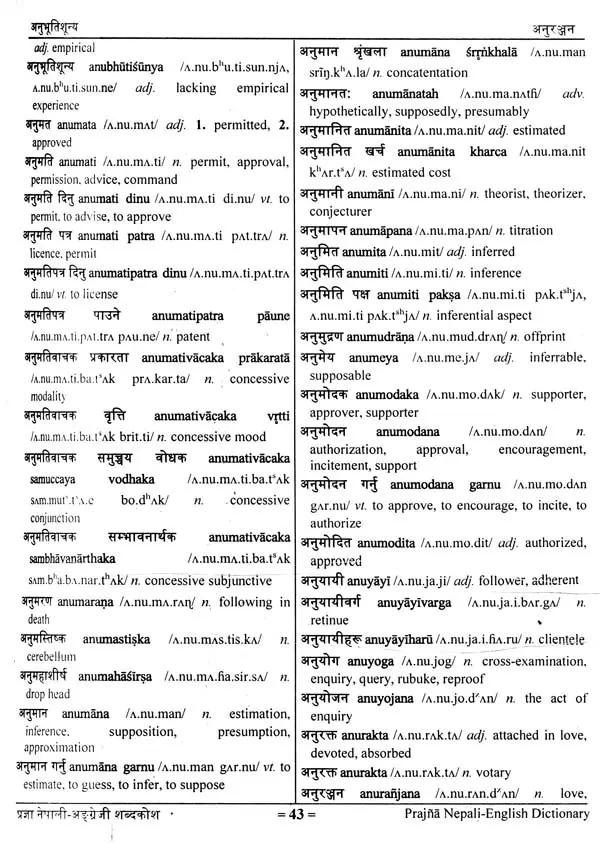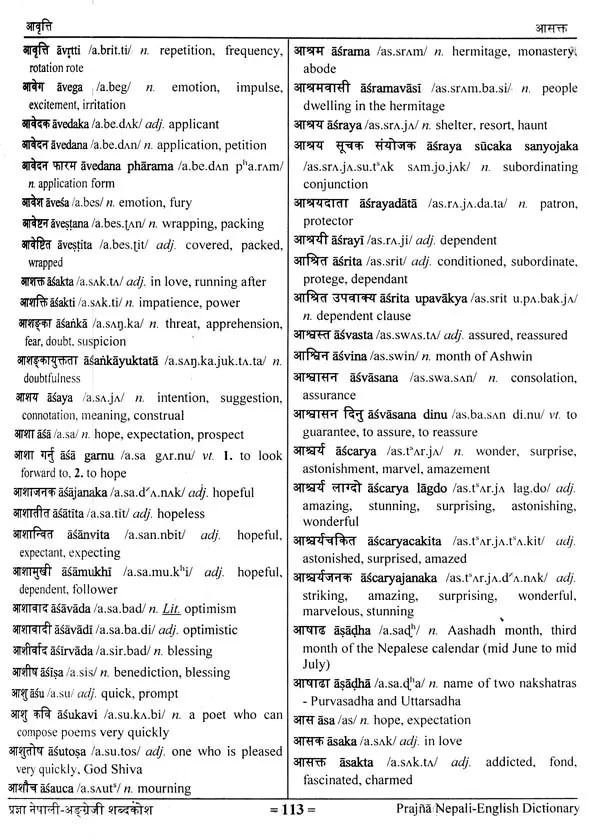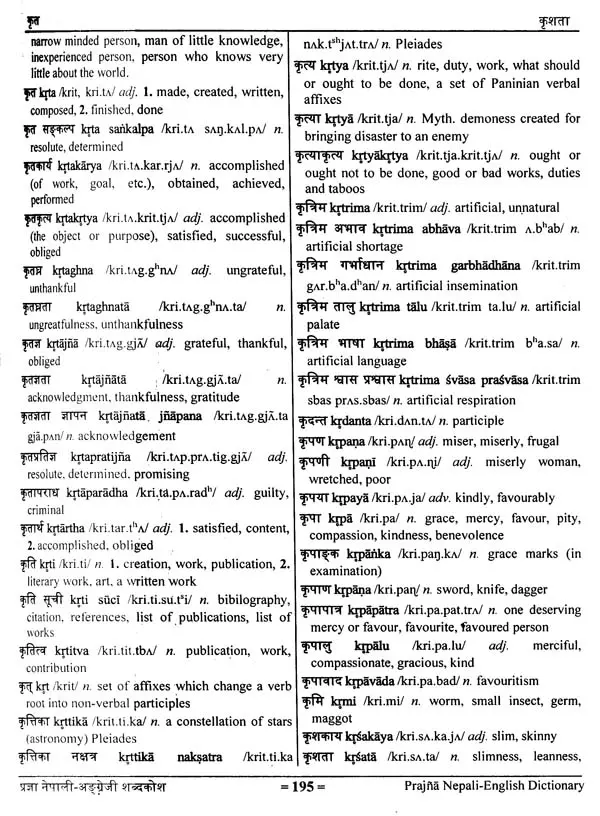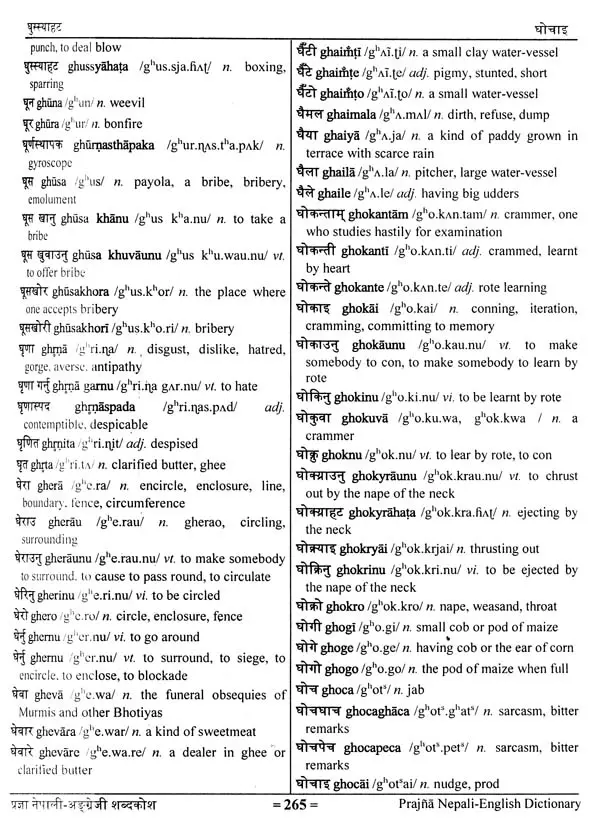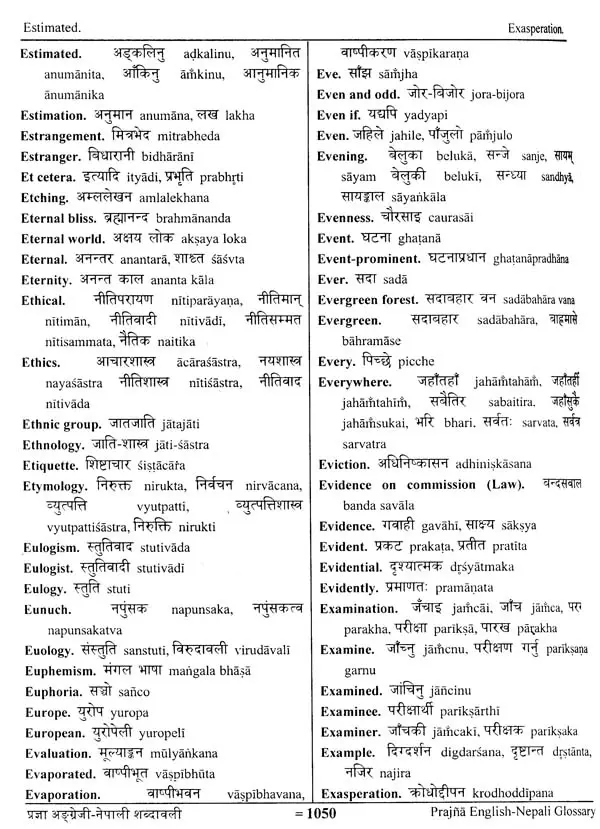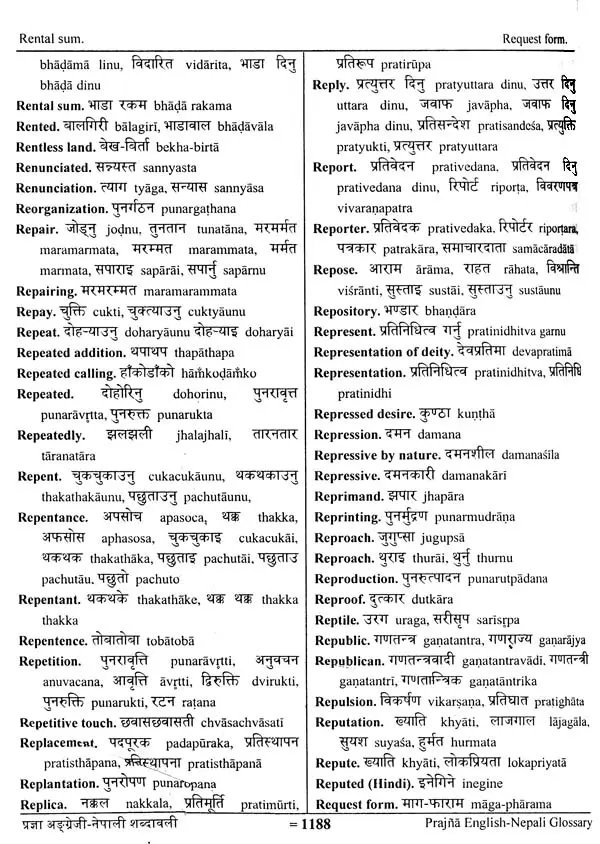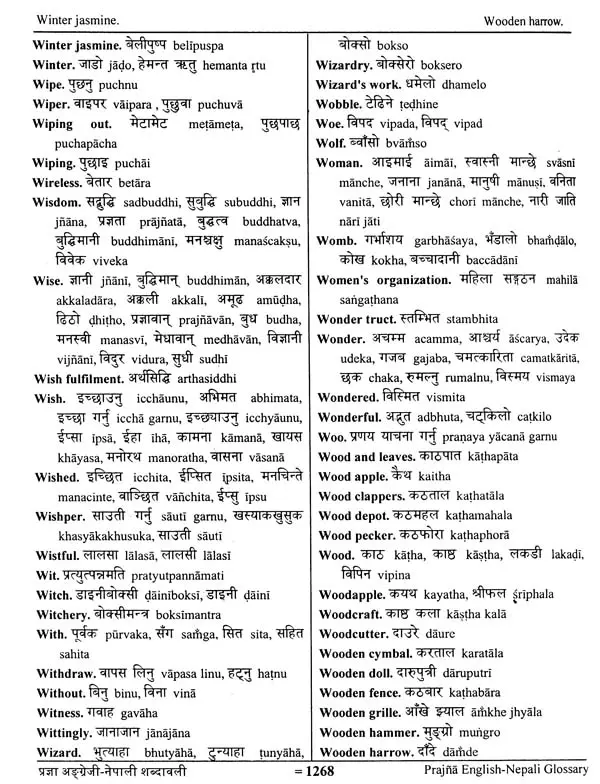
प्रज्ञा नेपाली-अङ्ग्रेजी शब्दकोश- Prajna Nepali-English Dictionary (with English-Nepali Glossary)
Book Specification
| Item Code: | UAG834 |
| Author: | Various Author |
| Publisher: | NEPAL Academyn, Kathmandu |
| Language: | Nepali text with English translations |
| Edition: | 2013 |
| ISBN: | 9789937589550 |
| Pages: | 1292 |
| Cover: | HARDCOVER |
| Other Details | 10.00 X 7.50 inch |
| Weight | 1.91 kg |
Book Description
years. Bamu Khadka's column inscription (Shake Samvat 1016) mentioned in Nepali bhashaka hajar varsh ('one thousand years of the Nepali language'; 2012» written by Mohan Prasad Khanal is the first written document so far available. The Khas-Prakrit language used as the official language of the western Nepal around the eleventh century initially developed as the written form to express the court orders or gazettes, genealogy or salutation, donations and characterization by the-then kings and princes. These inscriptions prepared on the basis of the above-mentioned writings constitute the first extant written form of Nepali language. Later, inscriptions, genealogies, characterization followed by tales of bravery and devotional sentiments assumed the form of literary Nepali language. Used in the name of Khas, Parvate and Gorkhali languages prior to one thousand years this language evolved as Nepali language. Despite being a mother tongue of the single Khas caste it attained the status of an official language. Hence, the rulers of different dynasties who reined this part during the various historical periods accepted this language as the official language owing to its communicative efficiency. Being a lingual franca all the communities in Nepal preferred to use this language in public domains. The Nepali language, used in the domains of conversation, administration and also as the language of wider communication among various communities in Nepal, had also been developing as an easy' means of expression in literature and various spheres of knowledge. In addition, it established itself as the foundation of entire identity among the different communities of Nepal is inside the country and in the diaspora. This language, limited only to Nepal and a part of India, is now being globalized all over the world. The Nepalese migrants in the different corners of the universe have contributed immensely to establish this language as the symbol of their identity. The Nepali language is thus undergoing the process o~ globalization on the one hand while, on the other, it has been emerging as the centre of attraction for foreign scholars interested in the study of oriental life style, philosophy and civilization. From this perspective, it has become important to render this language. easily accessible to the foreign scholars studying the oriental life style, philosophy and civilization. In this context the Nepalese organizations entrusted with the promotion of language, literature and culture have assumed still greater responsibility for making this language easily communicable for the native and foreign scholars. It is important for Nepal Academy, the common platform for Nepalese academics, to be involved in this pursuit.
To address the elaboration of the domains of use of Nepali Language and the interest of foreign scholars in Nepal and the Nepali language the compilation of a standard Nepali-English dictionary was felt necessary. Consequently, Nepal Academy decided to produce this dictionary with the involvement of some specialists in the field of lexicography. In the course of fulfilling this demand Prajna Nepali English Dictionary (with English-Nepali glossary) has been published for readers. This dictionary has been targeted to the two groups of readers: a. the individual’s familiar with English and b. the individuals who are proficient in Nepali and want to translate texts from Nepali into English and vice versa. Similarly, it has also been tailored to the needs of the general readers, students and teachers of both Nepali and English. In this sense we expect this dictionary to make Nepali books accessible to foreign scholars and translate texts in foreign languages into Nepali. It was imperative to have a standard Nepali-English dictionary for the promotion and extension of the Nepali language. To cater this need there have been made some individual efforts from native and foreign scholars though there had been lack of such initiatives on institutional basis. Of these the work by Ralph Lilley Turner has been highly appreciable. Turner's A Comparative and Etymological Dictionary of Nepali Language published first in 1931 has so far been the standard bilingual dictionary of the Nepali language. Later a few individuals and publishers published Nepali-English dictionaries with private investment. Of them the bilingual dictionaries by Parasmani Pradhan (1971), Ekta Prakashan (2067/2010), Ruth Laila Schmith (1993) and Tika Bahadur Karki (2001) are worth mentioning. The efforts made on the institutional basis are relatively marginal in comparison to those made by individual Nepalese and foreign lexicographers in the sphere of developing Nepali-English dictionaries. Keeping the contemporary needs and the negligible existence of such dictionaries Nepal Academy has prepared this bilingual dictionary with about 50,000 entries along with English-Nepali glossary in keeping with the view of compiling a standard bilingual dictionary. In this bilingual dictionary, first prepared on an institutional basis, each entry has been specified with its Roman transcription, pronunciation (using IPA symbols) and English meanings. In this respect this dictionary stands out as a novel attempt and is considered easier for its users. As the technical details are presented in the users' guides of this dictionary (see Editorial), it is not necessary .to repeat them here for the publisher's side.
This dictionary has been jointly compiled by the editorial board with Mr. Ganga Prasad Uprety as the coordinator, who is the Vice Chancellor of Nepal Academy and the chief of the Academy's Department of Nepali Language, Dictionary and Grammar. The other members of the editorial board include Professor Dr. Chudamani Bandhu, Professor Dr. Yogendra Prasad Yadava, Professor Dr. Madhav P. Pokharel and Professor Dr. Krishna Chandra Sharma. It could not have been published in the present form without the untiring effort of these experts in Nepali and English languages. We, therefore, express our sincere gratitUde to them. The major source of the entries in this dictionary is Brihat Nepali Shabdakosh ('Comprehensive Nepali Dictionary') published by Nepal Academy. The entries of greater frequency were selected from this dictionary by Karnakhar Khatiwada and Shim Narayan Regmi, Lecturers in Central Department- of Linguistics, T.U. and Prefessor Dr. Badri Vishal Bhattarai, Central Department of Nepali, T.U. They deserve our sincere thanks. Besides Brihat Nepali Shabdakosh, the entries were also collected from other relevant sources. Krishna Binnyas Poudel contributed significantly in sifting entries from these sources and arranging all the collected entries alphabetically. He helped us in rendering this dictionary technically possible during his tenure at Nepal Academy as well as' his stay in Australia. We thank him very much for his support. Srijana Sharma Uprety, involved in updating Brihat Nepali Shabdakosh as technical assistant, also accomplished technical activities related to this dictionary under Krishna Poudel's guidance during the later phase of compiling this dictionary. We also express our thanks to her for her vital support. Providing English meanings to the selected Nepali entries was another difficult task.
Book's Contents and Sample Pages
